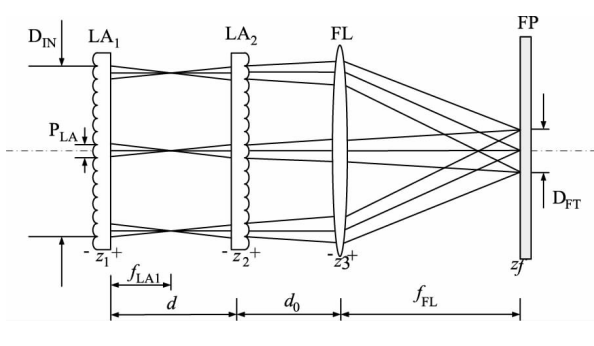Author: Time:2023-02-28
Gaussian light homogenization
microlens array is different from the structure of traditional optical
elements, which makes it have many excellent effects and functions. Common
applications of microlens array include: laser homogenization, Gaussian light
shaping, Gaussian light homogenization, wavefront detection, fiber coupling,
laser cutting, etc. Among them, laser homogenization, Gaussian light shaping
and Gaussian light homogenization are the most common. Because, whether used in
laser processing or lighting, fiber coupling and Gaussian light homogenization
can greatly improve the effect and process controllability. However, there are
many types of microlens arrays on the market, with complex parameters and
different manufacturers. So how to select a suitable microlens array based on
your own laser homogenization requirements? This paper briefly introduces the
homogenization scheme of dual arrays, and the selection of microlens array for
Gaussian light homogenization shaping.
The optical path diagram of
Gaussian light shaping scheme for laser homogenization of double microlens is
as follows:

LA1, LA2, FL and FP are respectively microlens array 1, microlens array
2, focusing lens and imaging focal plane from left to right. It can be seen
from the above figure that the structure of microlens array is flat and convex.
The plane is opposite, and the convex surface is the structure with microlens.
The incident Gaussian laser to be homogenized and shaped is collimated from the
left and then incident into the microlens array. The sub-unit aperture of the
two Gaussian light homogenizing microlens arrays should be consistent and
close. The spacing between microlens arrays is equal to the focal length of
microlens array 1, which is generally slightly larger. The distance between the
microlens array and the focusing lens FL will slightly affect the divergence
angle of the homogenized light spot, but the influence is small, and is
generally ignored in the selection calculation. In practice, this distance can
be adjusted to fine-tune the effect and size of the microlens array. The end is
the effect end of Gaussian light homogenization of microlens array.
The relationship between the
size of the laser homogenization spot of the microlens is as follows: (pLA is the aperture
size of the sub-unit of the lens array)
DFT=pLA·fFL·(fLA1+fLA2-a12)/(fLA1·fLA2)
Under the conditions shown in the upper light path, a12=fLA2, the above
formula can be simplified as follows:
DFT= pLA·fFL/
fLA2
Therefore, according to the formula, the required microlens array
parameter range and target direction can be obtained simply. It is assumed that
the homogenization requirement is to form a 10 * 10mm square spot at 300mm.
Then there is: DFT=10mm, fFL=300mm, and the ratio of
aperture to focal length of microlens array can be calculated by taking the
formula: pLA/fLA2=0.03333. If it is a rectangle, calculate the long and short
sides respectively.
In theory, the smaller the
aperture of the microlens, the better the homogenization effect. However, if
the aperture is too small, there will be diffraction interference, and the
final homogenization effect of hardness is not so good. Therefore, it is
generally recommended that the caliber should be slightly enlarged when
selecting models. The aperture requirement of the microlens is determined, and
the corresponding focal length can be calculated according to this
pLA/fLA2=0.03333, and the acceptable microlens parameter range can be obtained
at the same time.
In the optical path, the main
function of the focusing lens at the end of the microlens is to improve the
homogenization effect and adjust the position and size of the Gaussian light
homogenization, which is not necessary. If the required light spot is far away
or large, it can be removed.
It should be noted that because
the periodic microlens array is selected, there are certain requirements for
the light source itself. If it is a light source with small M2 and high
coherence, the Gaussian light shaping and homogenization effect of microlens
array is not so good. For this light source, it is recommended to use
diffractive shaping homogenizing elements to achieve high homogenization. Of
course, you can also pass light through the scattering plate first and then
incident it to the microlens array homogenizer group, but the effect is not
cost-effective, and is generally not recommended.
In the process of using the
dual-piece microlens array, it is particularly important to align the centers
of the two microlens arrays. This can be adjusted by rotating the lens and
moving it slightly. Due to the area accuracy of the microlens array and the
quality of the light source, the homogenized light spot will have a certain
amount of speckle, which is a normal phenomenon. Due to the weak speckle, the
final use is generally not affected. However, speckle removal requires high
accuracy, costs a lot and is not cost-effective. This is a common phenomenon of
microlens array shaping, both at home and abroad.
Product Navigation : Microlens Array Off axis
link : Sina Blog Alibaba163 Blog
Copyright: Highlight Optics Co., Ltd. Address:4A150 No.1 Trading Plaza, China South City, Longgang District, Shenzhen, China
Phone: 0086 0755 89319011 Email: sales@highlightoptics.com